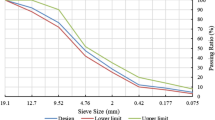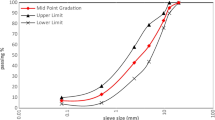Abstract
Moisture damage and rutting are the most prevalent defects of hot mix asphalts (HMA). Adhesion between materials and bitumen is an important factor that affects the failure of the asphalt mixtures. Various methods, such as using additives in the form of bitumen extender, have strengthened the asphalt mixture's resistance to moisture and rutting. In this study, super performance grade (SPG) polymer was used as a bitumen extender to improve bonding between asphalt binder and aggregates. Four types of HMA containing PG 58–22 bitumen with a replacement percentage of 20, 30, 40, and 50 SPG were prepared for this goal. Conventional properties of bitumen such as specific weight and viscosity (at 120, 135, and 160 °C), compaction temperature, and bitumen mixing as well as mechanical properties of the HMA such as moisture susceptibility with tensile strength ratio and Marshall stability ratio tests, and rutting (Marshall ratio) were evaluated. The results showed the improvement of conventional bitumen properties due to the addition of SPG. According to the results, SPG polymer as an extender bitumen increased the specific weight and viscosity of the bitumen as well as the density temperature and mixing of the mixture. The mechanical properties results also showed that adding SPG polymer as a bitumen extender improved the adhesion between bitumen and aggregates, leading to increased moisture and rutting resistance.






Similar content being viewed by others
References
Aksoy A, Şamlioglu K, Tayfur S, Özen H (2005) Effects of various additives on the moisture damage sensitivity of asphalt mixtures. Constr Build Mater 19(1):11–18
Shafabakhsh GH, Faramarzi M, Sadeghnejad M (2015) Use of surface free energy method to evaluate the moisture susceptibility of sulfur extended asphalts modified with antistripping agents. Constr Build Mater 98:456–464
Zahedi M, Zarei A, Zarei M (2020) The effect of lignin on mechanical and dynamical properties of asphalt mixtures. SN Appl Sci 2:1242. https://doi.org/10.1007/s42452-020-3041-4
Zarei M, Kordani AA, Zahedi M (2021) Evaluation of fracture behavior of modified Warm Mix Asphalt (WMA) under modes I and II at low and intermediate temperatures. Theor Appl Fract Mech 114:103015
Zahedi M, Barati M, Zarei M (2017) Evaluation of the effect of carbon nanotube on the rheological and mechanical properties of bitumen and Hot Mix Asphalt (HMA). Electron J Struct Eng 17(1):76–84
Hamedi GH, Shabani A, Safargar Y (2020) Investigating the effect of hydrophobic additives in moisture damage reduction of asphalt mixtures. Periodica Polytech Civ Eng 64(3):702–712
Zarei M, Abdi Kordani A, Zahedi M (2021) Pure mode I and pure mode II fracture resistance of modified hot mix asphalt at low and intermediate temperatures. Fatigue Fract Eng Mater Struct 44(8):2222–2243
Zarei A, Zarei M, Janmohammadi O (2018) Evaluation of the effect of lignin and glass fiber on the technical properties of asphalt mixtures. Arab J Sci Eng 44(5):4085–4094
Zarei M, Rahmani Z, Zahedi M, Nasrollahi M (2020) Technical, economic, and environmental investigation of the effects of rubber powder additive on asphalt mixtures. J Transp Eng, Part B: Pavements 146(1):04019039
Zahedi M, Zarei A, Zarei M, Janmohammadi O (2020) Experimental determination of the optimum percentage of asphalt mixtures reinforced with lignin. SN Appl Sci 2(2):258
Almeida A, Capitão S, Estanqueiro C, Picado-Santosc L (2021) Possibility of incorporating waste plastic film flakes into warm-mix asphalt as a bitumen extender. Construct Build Mater 291:123384
Wu J, Liu Q, Wang C, Wu W, Han W (2021) Investigation of lignin as an alternative extender of bitumen for asphalt pavements. J Clean Prod 283:124663
Uz VE, Gökalp İ (2020) Sustainable recovery of waste vegetable cooking oil and aged bitumen: optimized modification for short and long term aging cases. Waste Manage 110:1–9
Chen X, Li C, Jiang Y, Zhang W, Xu G (2019) Comparisons with high viscosity additive effects on base and modified asphalt. Pet Sci Technol 37(11):1331–1337
Yu H, Zhu Z, Leng Z, Wu C, Zhang Z, Wang D, Oeser M (2020) Effect of mixing sequence on asphalt mixtures containing waste tire rubber and warm mix surfactants. J Clean Prod 246:119008
Rahman MT, Mohajerani A, Giustozzi F (2020) Possible recycling of cigarette butts as fiber modifier in bitumen for asphalt concrete. Materials 13(3):734
Choudhary J, Kumar B, Gupta A (2021) Evaluation of engineering, economic and environmental suitability of waste filler incorporated asphalt mixes and pavements. Road Mater Pavement Des 22(sup1):S624–S640
Janmohammadi O, Safa E, Zarei M, Zarei A (2020) Simultaneous effects of ethyl vinyl acetate (EVA) and glass fiber on the properties of the hot mix asphalt (HMA). SN Appl Sci 2:1168. https://doi.org/10.1007/s42452-020-2977-8
Tarsi G, Caputo P, Porto M, Sangiorgi C (2020) A study of rubber-REOB extender to produce sustainable modified bitumens. Appl Sci 10(4):1204
White G, Magee C (2019) Laboratory evaluation of asphalt containing recycled plastic as a bitumen extender and modifier. J Traffic Transp Eng 7:218–235
Brovelli C, Crispino M, Pais J, Pereira P (2015) Using polymers to improve the rutting resistance of asphalt concrete. Constr Build Mater 77:117–123
Strickland D, Colange J, Shaw P, Pugh N (2008) Study of the low-temperature properties of sulphur extended asphalt mixtures. In: Proceedings of the fifty-third annual conference of the Canadian technical asphalt association (CTAA) Canadian technical asphalt association
White G, Reid G (2018) Recycled waste plastic for extending and modifying asphalt binders. In: 8th Symposium on Pavement Surface Characteristics: SURF 2018 – Vehicle to Road Connectivity Brisbane, Queensland, 2018
Sojobi AO, Nwobodo SE, Aladegboye OJ (2016) Recycling of polyethylene terephthalate (PET) plastic bottle wastes in bituminous asphaltic concrete. Cogent Eng 3(1):1133480
Leng Z, Sreeram A, Padhan RK, Tan Z (2018) Value-added application of waste PET based additives in bituminous mixtures containing high percentage of reclaimed asphalt pavement (RAP). J Clean Prod 196:615–625
Ait-Kadi A, Brahimi B, Bousmina M (1996) Polymer blends for enhanced asphalt binders. Polym Eng Sci 36(12):1724–1733
Vila-Cortavitarte M, Lastra-González P, Calzada-Pérez MÁ, Indacoechea-Vega I (2018) Analysis of the influence of using recycled polystyrene as a substitute for bitumen in the behaviour of asphalt concrete mixtures. J Clean Prod 170:1279–1287
Pérez IP, Pasandín AMR, Pais JC, Pereira PAA (2019) Use of lignin biopolymer from industrial waste as bitumen extender for asphalt mixtures. J Clean Prod 220:87–98
Raouf MA, Williams CR (2010) General rheological properties of fractionated switchgrass bio-oil as a pavement material. Road Mater Pavement Des 11(sup1):325–353
Aziz MMA, Rahman MT, Hainin MR, Bakar WAWA (2015) An overview on alternative binders for flexible pavement. Constr Build Mater 84:315–319
Vamegh M, Ameri M, Naeni SFC (2020) Experimental investigation of effect of PP/SBR polymer blends on the moisture resistance and rutting performance of asphalt mixtures. Construct Build Mater 253:119197
AASHTO (2009) Standard method of test for specific gravity of semi-solid bituminous material AASHTO T 228–04, Washington, DC
A. D. M-10 (2010) Standard test method for kinematic viscosity of asphalts (bitumens), ed: ASTM International West Conshohocken, PA
ASTM, A (2015) D6927–15 Standard test method for marshall stability and flow of asphalt mixtures. ASTM International: West Conshohocken, PA, USA
AASHTO T283 (2007) Standard method of test for resistance of compacted asphalt mixtures to moisture-induced damage. American Association of State and Highway Transportation Officials, Washington
Do TC, Tran VP, Lee HJ, Kim WJ (2019) Mechanical characteristics of tensile strength ratio method compared to other parameters used for moisture susceptibility evaluation of asphalt mixtures. J Traffic Transp Eng (English Edition) 6(6):621–630
Kok BV, Kuloglu N (2007) The effects of different binders on mechanical properties of hot mix asphalt. Int J Sci Technol 2(1):41–48
Faramarzi M, Golestani B, Lee KW (2017) Improving moisture sensitivity and mechanical properties of sulfur extended asphalt mixture by nano-antistripping agent. Constr Build Mater 133:534–542
Acknowledgements
The authors thank Ghaem Engineering and Construction Development Company, for their generous help during this study.
Author information
Authors and Affiliations
Corresponding author
Ethics declarations
Conflict of interest
No potential conflict of interest was reported by the authors.
Rights and permissions
About this article
Cite this article
Abdi Kordani, A., Zamankhani, A. & Zarei, M. The effect of super performance grade (SPG) polymer on properties of bitumen and hot mix asphalt (HMA). Innov. Infrastruct. Solut. 6, 214 (2021). https://doi.org/10.1007/s41062-021-00587-w
Received:
Accepted:
Published:
DOI: https://doi.org/10.1007/s41062-021-00587-w




